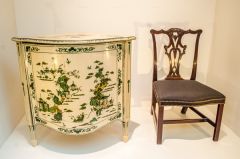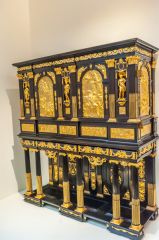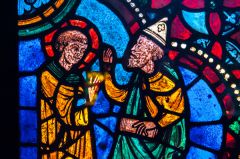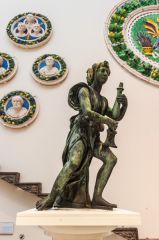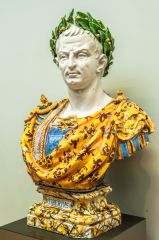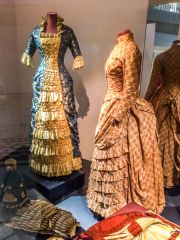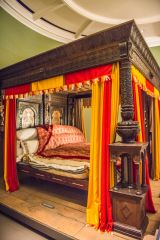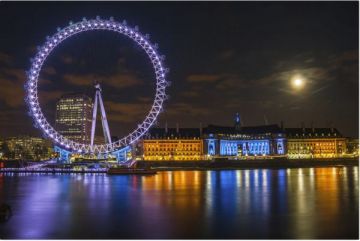
The Victoria and Albert Museum is a superb museum of the decorative arts, including furniture, jewellery, carpets, sculpture, reliquaries, prints, fashion, and more. The V&A, as it is often called, bills itself as the world's greatest museum of art and design, a claim that most visitors will be inclined to agree with!
The Victoria and Albert Museum is a superb museum of the decorative arts, including furniture, jewellery, carpets, sculpture, reliquaries, prints, fashion, and more. The V&A, as it is often called, bills itself as the world's greatest museum of art and design, a claim that most visitors will be inclined to agree with!
History
The museum can trace its roots back to the Great Exhibition of 1851. The Exhibition, the brainchild of Prince Albert, was the first international exhibition of manufactured goods, a kind of world fair of manufacturing, a place for science and industry of all nations to showcase their finest work.
The exhibition, held in Hyde Park, was such a financial success that there was profit left over to purchase large tracts of land in South Kensington. Several museums were established on the newly purchased land, including a Museum of Manufactures, the forerunner of today's V&A.

The Museum collection was at first simply formed of exhibits purchased from the Great Exhibition. But its mandate of making art available to all, and to inspire British designers and manufacturers, and to educate working people, made it clear that there was more to come.
In 1857 the museum moved to its current location and was renamed the South Kensington Museum. The museum was well funded, and set about collecting the very finest available examples of textiles, furniture, and metalwork, not just from Britain but from around the world, and not just current examples but artefacts from all time-periods. As well as decorative arts, the museum gathered collections of fine art, including drawings, sculpture, and paintings.

With an expanding collection, the museum needed to expand as well. Several new exhibition halls, framed with iron and topped with glass roofs, were added to display the museum collections.
These new halls were never intended to be permanent, but they are still standing and form the basis for the current museum complex. The complex needed a grand entrance, and this was duly added in 1899, with the queen herself laying the foundation stone. To mark the occasion and to commemorate the support given to the museum by Prince Albert, the museum was renamed for a second time, and became the Victoria and Albert Museum.
The museum is global in scope, but has a distinctly British focus, with the British Galleries forming a core element of the museum.

What can you see?
Just about everything, would be a realistic answer! The V&A is vast, and to explore all that it holds would be the work of not days, not weeks, but literally months. What is fascinating about exploring the V&A is that you can enjoy exhibits both by region, but also by theme. So there are large galleries of decorative art from India, Japan, Asia, the Islamic world, and Europe, but also large themed galleries divided by types of object. You can explore galleries of furniture, ceramics, sculpture, photography, paintings, jewellery, silver, and architecture. No matter what your interest, the V&A has an extraordinary wealth of fascinating exhibits to enjoy.
But wait, there's more! The V&A is known for its support of modern art, and there are always changing exhibits of contemporary design. For example, on our last visit there was an exhibit on the early works of John Constable, the history of the wedding dress, and the photographs of Horst P. Horst.

Highlights:
- Early medieval stained glass and silver plate from different world religions
- 17th century Mazarin lacquered chest from Japan
- Renaissance sculpture from Italy
- The Wolsey Angels, made for the tomb of Cardinal Wolsey in 1524
- The Art Deco exhibit - wow!
- The Great Bed of Ware, made in 1590
This is a very subjective list of exhibits and objects that struck us on our last visit. Your interests may vary from ours, so be sure to check out the museum's own website for more detail on their current exhibits!
About Victoria and Albert Museum
Address: Cromwell Road, South Kensington, London,
Greater London,
England, SW7 2RL
Attraction Type: Museum
Location: Most visitors will come via the London Underground to South Kensington station. A tunnel leads directly from the underground to the V&A and is extremely easy to follow.
Website: Victoria and Albert Museum
Email: contact@vam.ac.uk
Location
map
OS: TQ270 791
Photo Credit: David Ross and Britain Express
Nearest station: ![]() South Kensington - 0.2 miles (straight line) - Zone: 1
South Kensington - 0.2 miles (straight line) - Zone: 1
HERITAGE
 We've 'tagged' this attraction information to help you find related historic attractions and learn more about major time periods mentioned.
We've 'tagged' this attraction information to help you find related historic attractions and learn more about major time periods mentioned.
Historic Time Periods:
Find other attractions tagged with:
17th century (Time Period) - Burne-Jones (Person) - Cardinal Wolsey (Person) - Edward Burne-Jones (Person) - Medieval (Time Period) - Victorian (Time Period) -
NEARBY HISTORIC ATTRACTIONS
Heritage Rated from 1- 5 (low to exceptional) on historic interest
Brompton Oratory - 0.1 miles (Historic Church) ![]()
Science Museum - 0.2 miles (Museum) ![]()
Clockmakers' Museum - 0.2 miles (Museum) ![]()
Natural History Museum - 0.2 miles (Museum) ![]()
Albert Memorial - 0.5 miles (Historic Building) ![]()
Holy Trinity, Sloane Street - 0.7 miles (Historic Church) ![]()
Saatchi Gallery - 0.7 miles (Museum) ![]()
Kensington Gardens - 0.8 miles (Park) ![]()
Nearest Holiday Cottages to Victoria and Albert Museum:
Leaves Green, Greater London
Sleeps: 6
Stay from: £871 - 3127
Holmbury St Mary, Surrey
Sleeps: 9
Stay from: £855 - 4619
More self catering near Victoria and Albert Museum
